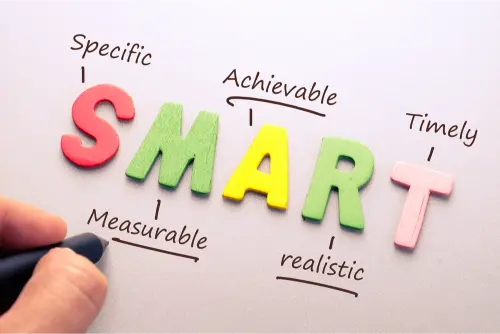In the journey toward achieving weight loss goals, setting vague aspirations like “I want to lose weight” or “I want to be healthier” often lead to frustration and disappointment. Without clear direction and actionable steps, it’s easy to become overwhelmed or lose motivation. This is where SMART goals come into play, providing a structured approach to goal setting that increases the likelihood of success.
What are SMART Goals?
SMART is an acronym that stands for Specific, Measurable, Achievable, Relevant, and Time-bound. When applied to weight loss, SMART goals help individuals define their objectives clearly, track progress, stay motivated, and ultimately achieve sustainable results.
Specific: Your goal should be well-defined and clear. Instead of saying, “I want to lose weight,” specify how much weight you want to lose and what actions you will take to achieve it. For example, “I want to lose 10 pounds by exercising regularly and following a balanced diet.”
Measurable: Your goal should be quantifiable so that you can track your progress. This could involve tracking your weight, measurements, or other metrics such as body fat percentage or clothing size.
Achievable: Set goals that are realistic and attainable. Consider your current lifestyle, commitments, and resources when setting your goals. While it’s important to challenge yourself, setting unrealistic goals can lead to frustration and demotivation.
Relevant: Your goals should align with your overall objectives and priorities. Consider why you want to lose weight and how it fits into your broader health and wellness goals. Ensure that your goals are meaningful and relevant to you personally.
Time-bound: Set a deadline for achieving your goal to create a sense of urgency and accountability. Having a specific timeframe will help you stay focused and motivated. For example, “I will lose 10 pounds within the next three months.”
Implementing SMART Goals for Weight Loss
Let’s break down how someone might apply SMART goals to their weight loss journey:
Specific: Instead of simply aiming to “lose weight,” set a specific goal such as, “I want to lose 10 pounds.”
Measurable: Track your progress by regularly weighing yourself or measuring your body dimensions.
Achievable: Determine realistic actions you can take to achieve your goal, such as exercising for 30 minutes five times a week and following a balanced diet.
Relevant: Consider how losing weight aligns with your broader health and wellness objectives, such as improving your energy levels or reducing your risk of chronic diseases.
Time-bound: Set a deadline for achieving your goal, such as “I will lose 10 pounds within the next three months.”
Benefits of Using SMART Goals for Weight Loss
Clarity: SMART goals provide clarity and direction, making it easier to know what steps to take to achieve your objectives.
Motivation: Having specific, measurable goals can boost motivation by allowing you to track your progress and celebrate your achievements along the way.
Accountability: Setting deadlines and measurable targets creates a sense of accountability, encouraging you to stay on track and make consistent efforts toward your goal.
Adaptability: SMART goals allow for adjustments based on your progress and changing circumstances. If you find that a particular approach isn’t working, you can modify your goals accordingly.
Incorporating SMART goals into your weight loss journey can significantly increase your chances of success. By setting specific, measurable, achievable, relevant, and time-bound objectives, you can stay focused, motivated, and ultimately achieve your desired results in a sustainable manner. Remember to regularly review and adjust your goals as needed, and celebrate your progress along the way. With determination, consistency, and SMART goal-setting, you can turn your weight loss aspirations into reality.

